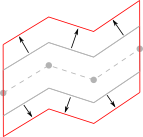Class TLspGeoBufferEditor
java.lang.Object
com.luciad.view.lightspeed.editor.ALspEditor
com.luciad.view.lightspeed.editor.TLspGeoBufferEditor
- All Implemented Interfaces:
ILspEditor
Enables visual editing of

ILcd2DEditableGeoBuffer and
TLcdLonLatBuffer objects in an ILspView.
Handles
The buffer editor defines the following edit handles for a buffer object:- Point handles: allows the user to edit the base shape of the buffer object. The
user can change the points of the base shape by dragging the handles. This handle generates
MOVEoperations, with aPOINT_INDEXproperty. - Outline handle: allows the user to change the width of the buffer by dragging the
outline. this handle generates
PROPERTY_CHANGEoperations, with ""width"" as property name, and aDoubleas value. - Object translation handle: allows the user to translate the buffer object. This handle
generates
MOVEoperations, without any additional properties.

Editing
Based on theTLspEditOperation, generated by an edit handle (see description
of handles above), this editor performs different edit operations on the associated buffer object.
The images below illustrate the effect of the different handles. In each image the
gray color represents the previous state of the object and the red color represents the edited object:
-
Point handles: Allows to edit the base shape of the buffer object.

-
Outline handle: Allows to edit the width of the buffer by dragging its outline.

-
Object translation handle: the editor translates the entire buffer.

Creation
The creation process of a buffer object consists of 2 steps:- Add new points to the buffer
- After adding all points to the buffer, initialize the width of the buffer
 |
 |
|
| Adding points to the buffer | Initializing the width |
- Since:
- 2012.0
-
Nested Class Summary
Nested ClassesModifier and TypeClassDescriptionstatic enumDefines keys used by the enclosing editor implementation to store properties in its edit handles. -
Constructor Summary
ConstructorsConstructorDescriptionCreates a newTLspGeoBufferEditor.TLspGeoBufferEditor(TLsp2DPointListEditor aCustomPointListEditorDelegate) Creates a newTLspGeoBufferEditor. -
Method Summary
Modifier and TypeMethodDescriptionbooleancanEdit(TLspEditContext aContext) Returnstrueifsuperreturnstrueand the given object is an instance ofTLcdLonLatBufferor an instance ofILcd2DEditableGeoBuffer.protected ALspEditHandlecreateBufferOutlineHandle(Object aObject, TLspEditContext aContext) Creates an edit handle that allows the user to adjust the width of the given buffer by modifying its outline.protected TLspEditOperationResulteditImpl(TLspEditOperation aOperation, ELspInteractionStatus aInteractionStatus, TLspEditContext aContext) Called by theeditmethod to edit the given object based on the givenedit operation.getCreateHandle(TLspEditContext aContext) Returns a handle that is used to create the given object.Returns how the delegate point list editor behaves during creation.getEditHandles(TLspEditContext aContext) Returns a set of handles for editing the given object.voidsetCreationMode(ELspCreationMode aCreationMode) Returns how the delegate point list editor behaves during creation.Methods inherited from class com.luciad.view.lightspeed.editor.ALspEditor
canCopyGeometry, canPerformOperation, copyGeometrySFCT, edit, fireUndoableHappened
-
Constructor Details
-
TLspGeoBufferEditor
public TLspGeoBufferEditor()Creates a newTLspGeoBufferEditor. This constructor initializes a defaultTLsp2DPointListEditorto be used as a delegate when editing and creating points in a geobuffer. -
TLspGeoBufferEditor
Creates a newTLspGeoBufferEditor. This constructor uses the givenTLsp2DPointListEditoras a delegate when editing and creating points inside a geobuffer.- Parameters:
aCustomPointListEditorDelegate- the delegate point list editor to be used for creating and editing points in this pointlist.
-
-
Method Details
-
canEdit
Returnstrueifsuperreturnstrueand the given object is an instance ofTLcdLonLatBufferor an instance ofILcd2DEditableGeoBuffer.- Specified by:
canEditin interfaceILspEditor- Overrides:
canEditin classALspEditor- Parameters:
aContext- provides context information to the editor- Returns:
trueif the above conditions are met,falseotherwise.
-
getEditHandles
Returns a set of handles for editing the given object. These handles will be able to generate edit operations, that are passed to theeditmethod. As a way to communicate with this method, handles will copy their properties to the edit operation properties. By default this method delegates to thecreateBufferOutlineHandlemethod. It is added for convenience, so it can easily be overridden. Further, it returns the same list of handles asTLsp2DPointListEditor.- Parameters:
aContext- provides context information such as the layer for which the object is being edited- Returns:
- the edit handles to edit the given object, or an empty list if it should not be possible to edit the given object.
- See Also:
-
createBufferOutlineHandle
Creates an edit handle that allows the user to adjust the width of the given buffer by modifying its outline.- Parameters:
aObject- the buffer object for which the handle is created, this can be of typeTLcdLonLatBufferorTLcdLonLatGeoBufferaContext- the current context- Returns:
- an edit handle or
nullwhen no handle is needed
-
getCreateHandle
Returns a handle that is used to create the given object. The returned handle is used by the controller to initialize the other of the object. Typically the returned handle is an instance ofALspCreateHandlewhich is a specialized handle implementation used for creating an object. By default, this method returns anALspCreateHandlecapable of creating anILcd2DEditableGeoBufferor aTLcdLonLatBuffer, as described in the class javadoc.- Parameters:
aContext- provides context information such as the layer for which the object is being created- Returns:
- an edit handle, or
nullif creation should not be allowed. - See Also:
-
editImpl
protected TLspEditOperationResult editImpl(TLspEditOperation aOperation, ELspInteractionStatus aInteractionStatus, TLspEditContext aContext) Called by theeditmethod to edit the given object based on the givenedit operation. Note that this method does not need to lock the model of the object, this already happens in theeditmethod. By default, this editor can handle the following operations:TLspEditOperationType.MOVETLspEditOperationType.INSERT_POINTTLspEditOperationType.REMOVE_POINTTLspEditOperationType.PROPERTY_CHANGE
POINT_INDEXproperty, with an integer value, then this editor will only perform the operation on that particular point, otherwise it will perform it on the entire point list. If the operation type isTLspEditOperationType.PROPERTY_CHANGE, and the name of the changed property is"width", the width of the buffer is modified.- Specified by:
editImplin classALspEditor- Parameters:
aOperation- the event that contains the information on how to edit the objectaInteractionStatus- the interaction statusaContext- the edit context- Returns:
SUCCESSif the above conditions are met,FAILEDotherwise. The invalidation hint will be set if a point was added or removed.
-
getCreationMode
Returns how the delegate point list editor behaves during creation.- Returns:
- the creation mode of the delegate point list editor
-
setCreationMode
Returns how the delegate point list editor behaves during creation.- Parameters:
aCreationMode- the creation mode to be set on the delegate point list editor
-